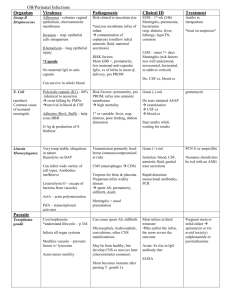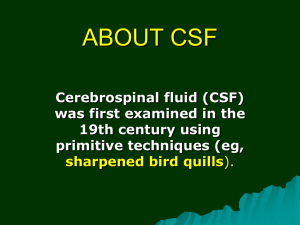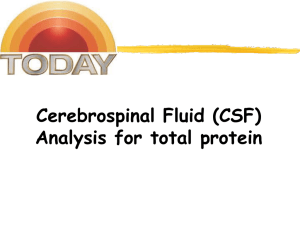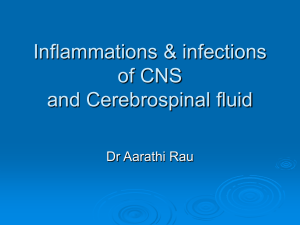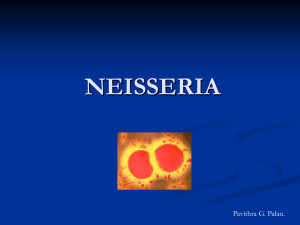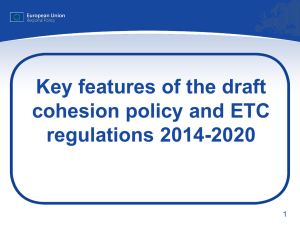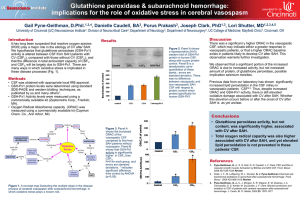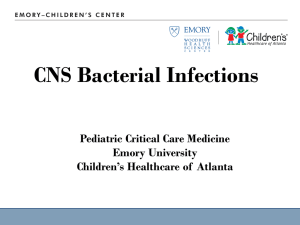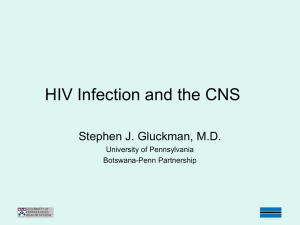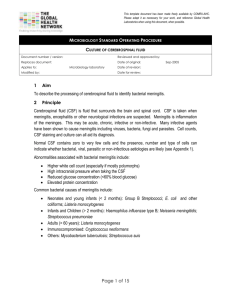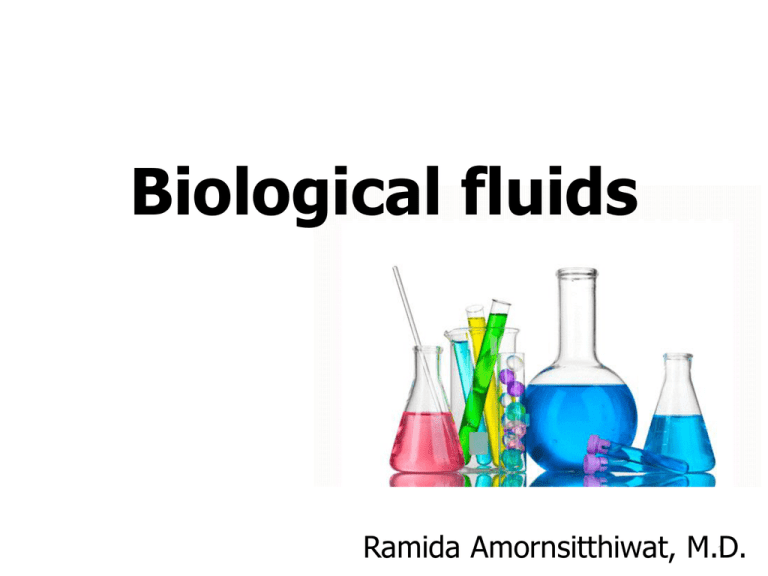
Biological fluids
1
Ramida Amornsitthiwat, M.D.
Biological fluids
•
•
•
•
•
Cerebrospinal fluid
Amniotic fluid
Seminal fluid
Saliva
Human milk
2
Cerebrospinal fluid (CSF)
• brain and spinal cord
• total volume : 125-150 mL
• daily production : 400-500 mL (20 mL/hr)
• synthesis : 70% choroid plexus
(active transport & ultrafiltration)
: 30% ependymal cells
• subarachnoid space, ventricular system
(space between arachnoid & pia mater)
3
CSF circulation
lateral ventricles
(choroid plexus)
foramen of Monro
third ventricle
cerebral aqueduct
fourth ventricle
foramen of Luschka & Magendi
basal cisterns & subarachnoid
space
reabsorption at venous sinus
via arachnoid granulations
4
CSF functions
• physical support of brain
• protection of brain
• chemical stability
• removes waste products of cerebral metabolism
5
Blood brain barrier (BBB)
• physiologic barrier (circulating blood & CSF)
- endothelial cell of brain capillaries
(tight junction, no intercellular pores)
- end-feet of astrocytes (astroglia)
• Infiltration
- fat-soluble drugs
(e.g. anesthetic & alcohol)
- glucose, urea & creatinine
- penicillin & streptomycin
- proteins
6
Examination of CSF
Lumbar puncture (LP)
7
Examination of CSF
Lumbar puncture (LP)
Indications
1. diagnostic
- CNS infection
eg. meningitis, encephalitis
- hemorrhage
- malignancy
- demyelinating disease
2. treatment
3. follow up
- spinal anesthesia
- antibiotics
- chemotherapy
8
Examination of CSF
Lumbar puncture (LP)
Contraindications
1. local infection at lumbar puncture site
2. intracranial mass lesion (brain herniation)
- large brain abscess
- brain tumor
- subdural hematoma
- intracranial hemorrhage
3. thrombocytopenia
9
Examination of CSF
Lumbar puncture (LP)
Complications
1. headache
: CSF leakage
2. cerebellar or tentorial herniation
:increase intracranial pressure
3. paralysis
4. meningitis
5. accidental puncture of the spinal cord
10
CSF analysis
•
•
•
•
pressure
gross appearance
microscopic examination
chemical analysis
11
CSF analysis
1. Pressure: 70 – 180 mmH2O
Increase intracranial pressure
1. brain edema
e.g.cerebral ischemia, meningitis, encephalitis
2. increase CSF volume
e.g. hydrocephalus
3. bleeding
e.g. intracerebral hemorrhage or subarachnoid hemorrhage
4. mass lesion
e.g. brain tumor, brain abscess
12
Increased CSF volume
normal
hydrocephalus
1. increased CSF production
2. obstruction of CSF circulation
3. decreased CSF reabsorption
13
CSF analysis
2. Gross appearance: clear / colourless
Abnormal findings
cloudy, turbid
meningitis
WBC > 200-300 /mm3
bloody
traumatic tap
subarachnoid hemorrhage
intracranial hemorrhage
xanthochromia
subarachnoid hemorrhage
(SAH)
14
Bloody CSF
Supernatant
(หลังปั่ น)
WBC
SAH
xanthochromia
(≥2 hr)
< 1:1000
three-tube test
ี ดงคงเดิม
สแ
red cells lysis
oxyhemoglobin (pink)
traumatic tap
ใส
~ 1:1000
(peripheral
blood)
ี างลง
สจ
ตามลาดับ
bilirubin (yellow)
onset : 2-4 hrs หลังจากเกิด SAH
15
Xanthochromia
•
สาเหตุอน
ื่ ๆ
1. jaundice
free and conjugated bilirubin in CSF
- total plasma bilirubin > 4-6 mg/dL
2. dietary hypercarotenemia
3. CSF protein > 150 mg/dL
4. drug e.g. rifampicin
16
CSF analysis
3. microscopic examination
WBC 0-5 cells/mm3
Abnormal findings
- leukocytes
- neutrophils in bacterial meningitis
- lymphocytes in viral meningitis
- tumor cells
- bacteria, fungi, yeast
17
Chemical analysis of CSF
Protein
- 12 - 60 mg/dL
- high protein ( > 65 mg/dL)
- permeability of BBB eg. meningitis
- traumatic tap, SAH
- obstruction of CSF
- CNS IgG synthesis
- low protein : no significance
18
Chemical analysis of CSF
Glucose
- plasma glucose CSF
(active transport & diffusion)
50-80 mg/dL
(60-70% or 2/3 of serum glucose)
- high glucose : hyperglycemia
- low glucose (<40 mg/dL or 40% serum glucose)
* meningitis – bacterial, TB, fungal
* hypoglycemia, SAH, neurosyphilis
* CNS leukemia & lymphoma
causes
1. abnormal transportation of glucose
2. increased glycolytic activity
3. glucose comsumption of leukocytes and microorganisms
19
Chemical analysis of CSF
Lactate
- anaerobic metabolism
- 10-22 mg/dL
CNS hypoxia
- meningitis
- hypotension
- brain injury
CSF lactate
- cerebral infarction
bacterial meningitis > viral meningitis
20
Chemical analysis of CSF
LDH (lactate dehydrogenase)
- meningitis, leukemia, cerebral ischemia
ammonia & glutamine
- hepatic encephalopathy
- ammonia
: toxic to CNS
- ammonia + glutamate
glutamine
IgG
- multiple sclerosis, neurosyphylis
Tumour markers
1. carcinoembryonic antigen (CEA)
2. -fetoprotein (AFP)
3. human chorionic gonadotropin (hCG)
21
Meningitis
• causes
- bacteria
- virus
- tuberculous
- parasite
- fungal
e.g.Cryptococcus
Brudzinski’s sign
Kernig’s sign
22
Meningitis
macroscopy
protein
(mg/dL)
tuberculous
clear
50-400
eosinophilic
+/- turbid
50-500
Cryptococcal
clear
50-500
meningitis
glucose
(mg/dL)
cells
bacterial
tuberculous
viral
(L)
N
(E>10%)
(L>P)
23
Amniotic fluid
:
:
:
:
:
cushioning the fetus
fetal movement
promoting muscular/skeletal development
controlling temperature
diagnostic tool for health & maturity of fetus
24
Amniotic fluid
• early pregnancy
- amniotic membrane
• late pregnancy
(16+ wk.)
- fetal urine
- fetal respiratory tract
- desquamated fetal cell
• Absorbed via fetal swallowing and amniotic
membrane
• maximal volume 1000 mL at gestational age
36 - 38 weeks (term pregnancy = 37- 42 weeks)
25
Abnormalities of amniotic fluid
1. volume
1.1 oligohydramnios
- < 400 mL
- renal agenesis, abnormality of urinary tract
1.2 polyhydramnios
- > 2000 ml
- acute
: fetal heart failure, hydrops fetalis
- chronic : anencephaly, esophageal atresia
2. color
blood, meconium, dark red-brown
26
Gross examination of amniotic fluid
color
เหลืองใส (หรือขุน
่ เล็กน ้อย)
เหลืองมาก
เขียว : meconium stain (ขีเ้ ทา)
แดงคล้า
condition
normal
HDN*
fetal hypoxia
fetal death
*HDN : hemolytic disease of the newborn
(erythroblastosis fetalis)
27
Amniocentesis
(prenatal diagnosis)
1. Transabdominal
2. Transcervical
3. Cul de sac
Complication of amniocentesis
1. Trauma
3. infection
2. Hemorrhage
4. amniotic fluid leakage
abortion 0.5-1%
preterm labour
28
Amniotic fluid analysis
• cytologic & DNA studies
- chromosomal disorders
- sex
• biochemical analysis
- alpha 1-fetoprotein (AFP)
- phospholipids
- bilirubin
29
Amniotic fluid analysis
30
Indications for chromosome study
1. มารดาอายุ > 35 ปี เมือ
่ ถึงวันครบกาหนดคลอด
2. มารดาและ/หรือบิดามีภาวะโครโมโซมผิดปกติ
3. มีบต
ุ รทีม
่ ภ
ี าวะโครโมโซมผิดปกติในครรภ์กอ
่ น
4. มีบต
ุ รพิการแต่กาเนิดโดยไม่ทราบสาเหตุ
ี ชวี ต
5. มีบต
ุ รเสย
ิ ในครรภ์โดยไม่ทราบสาเหตุ
6. บิดามารดาเป็ นพาหะของโรคถ่ายทอดทางกรรมพันธุแ
์ บบลักษณะด ้อย
31
Amniotic fluid analysis
α 1- fetoprotein (AFP)
• yolk sac and fetal liver
- high level : neural tube defects
- low level : Down syndrome
- can be detected in maternal serum
32
Amniotic fluid analysis
Phospholipids
- amphipathic molecule
- form micelle & lipid bilayer
- lecithin (dipalmitoylphosphatidylcholine - DPPC)
- phosphatidylglycerol (PG), sphingomyelin (S)
lung surfactant
Roles of Lung surfactant
surfactant decreases surface tension
•
pulmonary compliance
•
alveolar collapse
• Respiratory distress syndrome (RDS)
Fetal lung maturity
- L/S ratio
- phosphatidylglycerol
- foam stability or shake test
L/S < 1.5 immature
L/S 1.5-1.9 intermediate
L/S ≥ 2
lung maturity
34
Shake test (foam stability test)
Amniotic fluid + 95% ethanol
shake 30 sec
ตั้งทิง้ ไว้ 15 sec
ดูฟอง
• Qualitative test
• lung surfactant
foam stability
35
36
Amniotic fluid analysis
Isoimmunization
: fetal-maternal blood incompatibility
(hemolytic disease of the newborn)
ลูกคนแรก Rh +ve
Ag
เลือดมารดา Rh -ve
sensitized : ตรวจพบ Rh Ab ในเลือดมารดา
ลูกคนที่ 2 Rh +ve
Rh Ab ของแม่ ผ่านรกมาทาปฏิกริ ิยากับ Rh +ve ในเลือดของลูก
RBC
hemolysis
bilirubin
(scan spectrophotometer ที่ 450 nm)
37
Semen , Seminal fluid
a suspension of spermatozoa in the seminal plasma
38
Semen
testis
seminal vesicle
prostate gland
epididymis,
vas deferens,
bulbourethral
gland
5%
60%
spermatozoa
สารน้ าเหนียว, pH กลาง-ด่าง,
มี fructose ซงึ่ เป็ นแหล่งพลังงาน
ของ sperm
20%
คล ้ายน้ านม, pH เป็ นกรดอ่อน(~6.5)
ผลิต acid phosphatase &
proteolytic enzyme
(coagulation & liquefaction)
10-15% สร ้าง protein ทีจ
่ าเป็ นสาหรับ
การเคลือ
่ นทีข
่ อง sperm
39
Semen analysis
- gross examination
- microscopic examination
Indications
1. ประเมินภาวะมีบต
ุ รยาก (infertility)
2. ประเมินผลของการทาหมันชาย (vasectomy)
3. ประเมินผลประกอบคดีทางนิตเิ วช (forensic medicine)
40
Gross examination of semen
• volume : 2-5 mL
• coagulation process
- fibrin-liked precursor (seminal vesicle)
- clotting enzyme (prostate)
• liquefaction process
- proteolytic enzyme (prostate)
41
Microscopic examination of semen
• sperm count
normal 60-150 million/mL
oligospermia < 20 million/mL
azoospermia : no spermatozoa
• motility
motile spermatozoa 65-80 %
• sperm morphology
normal morphology 80-90 %
42
Analysis of semen
การประเมินผลของการทาหม ันชาย
- หลังทาหมัน 6 เดือน ไม่ควรตรวจพบ sperm
การตรวจอสุจป
ิ ระกอบคดีทางนิตเิ วช
1. sperm cytology
- 7 วัน หลังร่วมเพศ
2. acid phosphatase activity
- prostate gland
- 3 วัน หลังร่วมเพศ
- high sensitivity
43
Saliva
• Production
-
500-1500 mL/day
-
salivary gland
-
autonomic nervous system
-
physiological/pathological condition
parotid
sublingual
submandibular
• Composition
-
: serous
: mucous > serous
: serous > mucous
inorganic compounds
organic compounds
protein compounds
hormones
:
:
:
:
hypotonic fluid
uric acid
amylase,IgA
catecholamines
44
Biochemical laboratory analysis of saliva
1. viral and bacterial infections
- genome and antibodies detection
2. cancer
e.g. c-erb-2 soluble fragment
3. pharmaceutical and drug abuse
4. hormones
- cortisol
5. DNA test
- biomarker profiling or forensic identification
6. sialochemistry analysis
- heavy metal
Mumps
-
contagious disease : virus
children age 2-12 years
respiratory secretions, saliva
fever, headache, painful and swollen parotid gland at the
face, neck and jaw
- complications
: orchitis
: meningitis
: encephalitis
46
Human milk
Stage of lactation
1. colostrum
(first few days)
- immunologic compound (secretory immunoglobulin A)
2. transitional milk
(5 days-2 weeks)
- rumped up milk
3. fully mature milk
(4-6 weeks)
47
Human milk
Composition
1. Nutrition component
• macronutrient
- protein
- fat
- lactose
: casien, Haptocorrin (transcobalamin II),
α-lactalbumin, whey
: palmatic acid and oleic acid
• micronutrient
- vitamin
: low vitamin K
48
2. Bioactive component
3. Immunologic factors
bioactive factors
- bile-salt stimulated lipase
- epidermal growth factor
- growth factors
anti-infective factors
- secretory immunoglobulin A
(sIgA)
- white blood cells
- whey proteins (lysozyme and
lactoferrin)
- oligosacccharides
49

